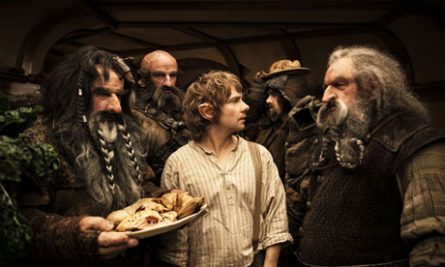
It’s actually somewhat of a surprise that it’s taken as long as it has to return to Middle Earth with the first of three planned film versions of the first of J.R.R. Tolkien’s novels to focus on the lives of the Baggins clan and the world of Dwarves, Men, Elves and Orcs. After initially begging off directing in favor of co-screenwriter Guillermo del Toro, Peter Jackson returns to helm this second trilogy as well. While the first foray back doesn’t reach the heights that the first trilogy managed to, at least right away, there’s enough in The Hobbit to be hopeful for the release of the next edition next year.
After a prologue that fills the audience in on the backstory, the older Bilbo Baggins that audiences were introduced to in The Fellowship of the Ring in 2001 (Ian Holm) begins to tell the story as he and his nephew Frodo (Elijah Wood, also returning) prepare for the birthday party that sets the initial trilogy in motion. The young Bilbo (Martin Freeman) is sitting in his home alone when Gandalf (Ian McKellan) arrives, trying to convince the middle-aged hobbit to embark on a mysterious adventure with some unknown companions. Later that night, Bilbo’s home becomes the clubhouse for a dozen dwarves, and Gandalf, who attempt to convince him to join with them in their quest to drive the dragon Smaug out of their ancient kingdom of Erebor. This group includes the rightful heir to the kingdom, Thorin Oakenshield (Richard Armitage). After initially refusing, Bilbo sets out to join the party, as they make their way toward the Lonely Mountain, under which the treasures of Erebor, now guarded by Smaug, sit. Thorin is also being pursued, unbeknownst to him, by the orc Azog, who suffered a traumatic wound at Thorin’s hands in battle and is seeking revenge.
For those who loved the first trilogy of Middle Earth films, The Hobbit will feel more like slipping under the covers rather than something to be feared. Since Tolkien’s initial intended audience for The Hobbit was children, the first film does seem to be a bit more kid-friendly than the previous series, at least initially. But things do get more intense, and darker, as the film moves along. Fans of the initial series will also be glad to see the return of many of the same actors, such as McKellan, Andy Serkis, Hugo Weaving, Cate Blanchett and Christopher Lee, to the parts they inhabited in the first series. The action, while a bit repetitive, especially for fans of the first series, is well choreographed and, for the most part, looks good. As the main newcomer, Freeman does a very nice job as Bilbo, portraying him as someone being pulled by fate against what he thinks is his better judgment. The scenes that work best, the return of Gollum and the game of riddles the two characters play, require that Freeman be able to more than hold his own against a character the audience already respects and fears, and he’s more than up to the task.
The movie’s run time, at a healthy 2 hours and 40 minutes, will keep some away. And, truth be told, The Hobbit doesn’t need to run nearly that long. One long sequence feels like a complete repeat of the Moria sequence in the first film of the first trilogy, for example. And the efforts made to differentiate the 12 dwarves, apart from Thorin and a couple of others, aren’t really satisfactory. While it’s cute that so many of the dwarves have similar sounding names and are of similar size, it makes it difficult to keep track of exactly who was whom at any given time, especially as things get moving. While there were fewer members of the Fellowship in the first film, it didn’t take much to know the differences between the 9 members. With 14, it’s harder to keep up. It’s also unclear how, exactly, Armitage is trying to portray Thorin. He’s clearly not as purely heroic as Aragorn, Viggo Mortensen’s character in the first series, but, at least in the early going, it’s not clear what makes him more than a generic hard case hero.
But fans of the initial series should take heart. Just as The Lord of the Rings got off to a promising start and improved as it went along, there’s enough that goes well in this first edition of The Hobbit, that people will still be lining up a year from now and a year after, happily. While there are some serious issues with the film, it still ranks, on the whole, as a quality piece of fantasy filmmaking.
(Note: This reviewer saw a 2-D screening of The Hobbit at the traditional 24-fps frame rate. As such, it will focus on the cinematography and other visuals at that speed, as opposed to the higher 48-fps it is also being shown in.)

